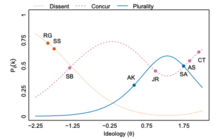
Abstract
Standard methods for measuring ideology from voting records assume that individuals at the ideological ends should never vote together in opposition to moderates. In practice, however, there are many times when individuals from both extremes vote identically but for opposing reasons. Both liberal and conservative justices may dissent from the same Supreme Court decision but provide ideologically contradictory rationales. In legislative settings, ideological opposites may join together to oppose moderate legislation in pursuit of antithetical goals. We introduce a scaling model that accommodates ends against the middle voting and provide a novel estimation approach that improves upon existing routines. We apply this method to voting data from the United States Supreme Court and Congress and show it outperforms standard methods in terms of both congruence with qualitative insights and model fit. We argue our proposed method represents a superior default approach for generating one-dimensional ideological estimates in many important settings.
